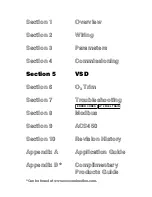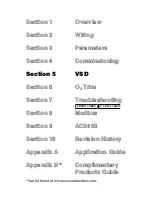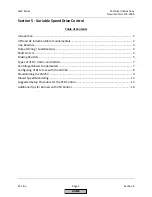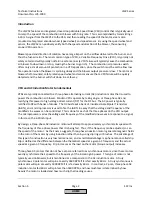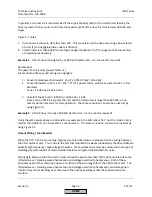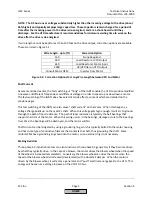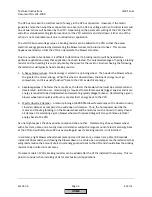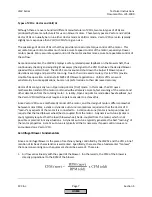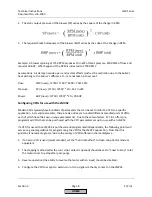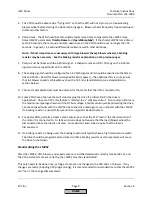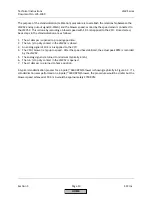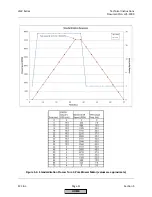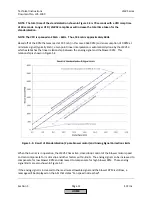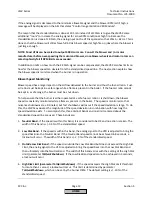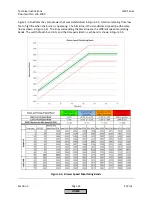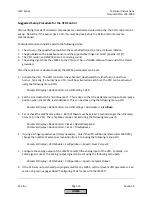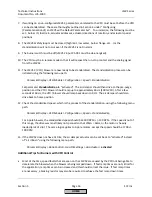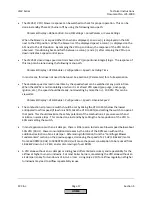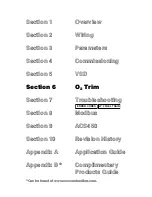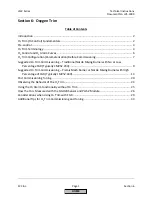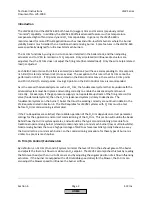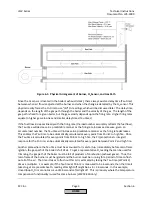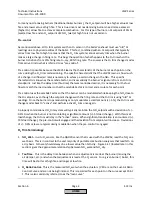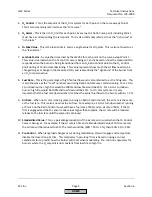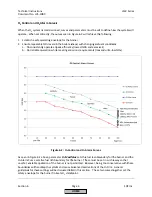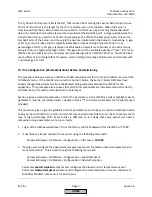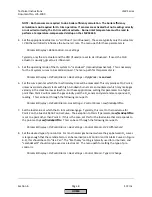
LMV
Series
Technical
Instructions
Document
No.
LV5
‐
1000
SCC
Inc.
Page
13
Section
5
If
the
analog
signal
is
decreased
to
the
minimum
allowable
signal
and
the
blower
RPM
is
still
high,
a
message
will
be
displayed
on
the
AZL
that
states
“Control
range
limitation
VSD
Module”.
The
reason
that
the
standardization
is
done
at
19.5mA
instead
of
at
20mA
is
to
give
the
LMV52
some
additional
"room"
to
increase
the
analog
signal
for
a
low
RPM
condition
at
high
fire.
Because
the
standardization
is
done
at
19.5mA,
the
analog
input
on
the
VFD
is
spanned
so
that
20mA
=
62
Hz.
This
is
done
so
that
the
blower
will
still
achieve
full
60
Hz
blower
speed
at
high
fire
on
jobs
where
the
blower
is
just
large
enough.
NOTE:
Most
VFDs
can
be
scaled
to
output
400
Hz
or
more.
Consult
the
blower
and
/
or
motor
manufacturer
before
over
‐
speeding
the
motor
and
blower,
since
blower
wheels
and
motor
rotors
can
catastrophically
fail
if
RPM
limits
are
exceeded.
In
addition
to
limits
on
how
much
the
4
‐
20mA
signal
can
be
compensated,
the
LMV52
also
has
limits
on
how
far
the
blower
speed
can
deviate
from
the
standardized
speed
line.
The
next
section
explains
how
the
blower
speed
is
monitored
when
the
burner
is
in
operation.
Blower
Speed
Monitoring
Blower
speed
has
a
large
impact
on
the
airflow
delivered
to
the
burner
and
thus
the
fuel
‐
air
ratio.
Fuel
‐
air
ratios
must
be
kept
in
a
safe
range
while
a
flame
is
present
in
the
boiler.
If
the
fuel
‐
air
ratio
cannot
be
kept
in
a
safe
range,
the
burner
must
be
shut
down.
To
help
ensure
that
the
burner
is
either
operated
at
a
safe
fuel
‐
air
ratio
or
is
shut
down,
the
blower
speed
is
constantly
monitored
while
a
flame
is
present
in
the
boiler.
The
speed
is
monitored
so
that
nuisance
shutdowns
are
eliminated,
but
fast
shutdowns
will
occur
if
the
speed
deviation
is
large.
To
do
this,
the
LMV52
evaluates
the
magnitude
of
the
speed
deviation
in
combination
with
how
long
the
speed
deviation
exists.
To
accomplish
this,
three
distinct
bands
and
one
limit
centered
about
the
standardized
speed
line
are
used.
These
bands
are:
1.
Neutral
Band
‐
if
the
speed
is
within
this
band,
it
is
considered
to
be
OK
and
no
action
is
taken.
The
width
of
this
band
is
+/
‐
0.5%
of
the
standardized
speed.
2.
Low
Risk
Band
‐
if
the
speed
is
within
this
band,
the
analog
signal
to
the
VFD
is
adjusted
to
bring
the
speed
back
into
the
Neutral
Band.
If
the
Neutral
Band
speed
cannot
be
achieved
in
8
seconds,
a
lockout
will
occur.
The
width
of
this
band
is
+/
‐
2.0
%
of
the
standardized
speed.
3.
Outside
Low
Risk
Band
‐
if
the
speed
is
outside
the
Low
Risk
Band
but
does
not
exceed
the
High
Risk
Limit,
the
analog
signal
to
the
VFD
is
adjusted
to
bring
the
speed
back
into
the
Low
Risk
Band
and
then
ultimately
into
the
Neutral
Band.
The
width
of
this
band
varies
with
the
setting
of
the
High
Risk
Limit
(parameter
TolQuickShutdown
).
If
the
Low
Risk
Band
speed
cannot
be
achieved
in
3
seconds,
a
lockout
will
occur.
4.
High
Risk
Limit
(parameter
TolQuickShutdown
)
‐
if
the
speed
exceeds
the
High
Risk
Limit
threshold
for
more
than
1
second,
a
lockout
will
occur.
This
limit
is
determined
by
parameter
TolQuickShutdown
,
which
can
be
set
by
the
burner
OEM.
The
default
setting
is
+/
‐
10%
of
the
standardized
speed.
HOME
Содержание LMV 5 Series
Страница 2: ...Intentionally Left Blank ...
Страница 25: ...LMV Series Technical Instructions Document No LV5 1000 SCC Inc Page 21 Section 1 Intentionally Left Blank HOME ...
Страница 27: ...LMV Series Technical Instructions Document No LV5 1000 SCC Inc Page 23 Section 1 Intentionally Left Blank HOME ...
Страница 41: ...LMV Series Technical Instructions Document No LV5 1000 SCC Inc Page 7 Section 2 HOME ...
Страница 42: ...Technical Instructions LMV Series Document No LV5 1000 Section 2 Page 8 SCC Inc HOME ...
Страница 43: ...LMV Series Technical Instructions Document No LV5 1000 SCC Inc Page 9 Section 2 HOME ...
Страница 44: ...Technical Instructions LMV Series Document No LV5 1000 Section 2 Page 10 SCC Inc HOME ...
Страница 45: ...LMV Series Technical Instructions Document No LV5 1000 SCC Inc Page 11 Section 2 HOME ...
Страница 46: ...Technical Instructions LMV Series Document No LV5 1000 Section 2 Page 12 SCC Inc HOME ...
Страница 47: ...LMV Series Technical Instructions Document No LV5 1000 SCC Inc Page 13 Section 2 HOME ...
Страница 48: ...Technical Instructions LMV Series Document No LV5 1000 Section 2 Page 14 SCC Inc HOME ...
Страница 49: ...LMV Series Technical Instructions Document No LV5 1000 SCC Inc Page 15 Section 2 HOME ...
Страница 50: ...Technical Instructions LMV Series Document No LV5 1000 Section 2 Page 16 SCC Inc HOME ...
Страница 51: ...LMV Series Technical Instructions Document No LV5 1000 SCC Inc Page 17 Section 2 HOME ...
Страница 52: ...Technical Instructions LMV Series Document No LV5 1000 Section 2 Page 18 SCC Inc HOME ...
Страница 53: ...LMV Series Technical Instructions Document No LV5 1000 SCC Inc Page 19 Section 2 HOME ...
Страница 54: ...Technical Instructions LMV Series Document No LV5 1000 Section 2 Page 20 SCC Inc HOME ...
Страница 55: ...LMV Series Technical Instructions Document No LV5 1000 SCC Inc Page 21 Section 2 HOME ...
Страница 56: ...Technical Instructions LMV Series Document No LV5 1000 Section 2 Page 22 SCC Inc Intentionally Left Blank HOME ...
Страница 116: ...Technical Instructions LMV Series Document No LV5 1000 Section 3 Page 58 SCC Inc Intentionally Left Blank HOME ...
Страница 150: ...Technical Instructions LMV Series Document No LV5 1000 Section 4 Page 32 SCC Inc Intentionally Left Blank HOME ...
Страница 170: ...Technical Instructions LMV Series Document No LV5 1000 Section 5 Page 18 SCC Inc Intentionally Left Blank HOME ...
Страница 290: ...Technical Instructions LMV Series Document No LV5 1000 Section 8 Page 20 SCC Inc Intentionally Left Blank HOME ...
Страница 306: ...Technical Instructions LMV Series Document No LV5 1000 Section 9 Page 14 SCC Inc Intentionally Left Blank HOME ...
Страница 373: ...Intentionally Left Blank ...

